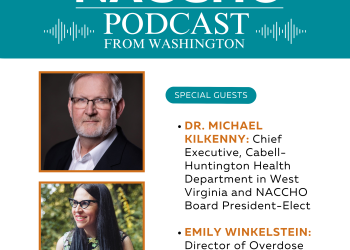With support from the Centers for Disease Control and Prevention (CDC) and in partnership with the University of Washington (UW), NACCHO is pleased to announce ‘Use of Learning Collaborative Model to Build Capacity of Syringe Services Programs to Conduct Point in Time Surveys’ one of two new funding opportunities to promote monitoring and evaluation (M&E) of syringe services programs (SSPs) and support the use of data for SSP program improvement.
Use of Learning Collaborative Model to Build Capacity of Syringe Services Programs to Conduct Point in Time Surveys
The purpose of this funding opportunity is to increase the capacity of SSPs to implement Point in Time surveys and support the use of collected data for SSP program improvement through participation in a Learning Collaborative. The funding opportunity will also seek to evaluate and demonstrate the effectiveness of a Learning Collaborative approach as a means of building SSP capacity for M&E and inform and strengthen future SSP M&E technical assistance opportunities and resources, including for Point in Time Surveys.
Through this Request for Applications (RFA), NACCHO will issue contracts of up to $50,000 to SSPs to support participation in and evaluation of the Learning Collaborative, including completion of deliverables related to the implementation of a Point in Time survey. Applications are due on January 6, 2022. Access the RFA here.
Webinar, Office Hours, and Resources:
Informational Webinar: NACCHO hosted an informational webinar for potential applicants on Monday, December 13th at 1 – 3 PM ET. The first hour of the webinar focused primarily on an associated RFA focused on SSP data analysis and evaluation. The second hour focused primarily on this RFA. A recording of the webinar can be accessed here and slides can be accessed here.
Offices Hours: NACCHO and UW will host office hours at the following times to answer questions about the RFA. Organizations can register here for one of four spots during each office hours session which will give them priority to discuss their questions with members of the NACCHO and UW team. If there are no more spots left for office hours, you can still join, but you will have to wait until after the first four organizations who register discuss their questions. To join office hours, use this Zoom link.
During the following three office hours, NACCHO and UW will answer questions about this RFA as well as an associated RFA focused on data analysis and evaluation:
- Tuesday, December 14th at 3 – 4 PM ET
- Thursday, December 16th at 1 – 2 PM ET
- Monday, December 20th at 2 – 3 PM ET
During the following office hours, NACCHO and UW will only answer questions about this RFA:
- Monday, January 3rd at 1 – 2 PM ET
Resources:
- See Appendix A in the RFA for a sample point in time survey staffing model
- Guidance and FAQ regarding implementation of point in time surveys
- Survey Bank: includes a bank of example survey questions
Application Submission & Attachments:
Applicants will need to submit the following documents to Kat Kelley, Senior Program Analyst, HIV, STI, & Viral Hepatitis ([email protected])—using the subject line “RFA Submission – “Use of Learning Collaborative Model to Build Capacity of Syringe Services Programs to Conduct Point in Time Surveys”—by January 6, 2022. For additional information, access the RFA here.
- Application Form (Word)
- Budget Template and Narrative
- Budget Guidance
- Contract Cover Sheet
- Vendor Information Form
- Certification of Non-Debarment
- W-9
- FFATA data collection form
- Proof of fringe and/or indirect costs in the budget, if applicable (see the contract cover sheet and budget guidance documents for more information)
- Optional: Letters of Support from partner organizations
Frequently Asked Questions
To submit a question about this RFA, contact Kat Kelley ([email protected]). This section will be updated as questions are submitted.
Eligibility
Q: Can we apply to and be eligible for both funding opportunities (Advancing Harm Reduction through Data Analysis & Evaluation and Use of Learning Collaborative Model to Build Capacity of Syringe Services Programs to Conduct Point in Time Surveys)?
A: Yes, organizations can apply to and could be funded for both funding opportunities.
UPDATED - 12/21/21
Q: Can we apply to this funding opportunity if we currently receive funding through NACCHO’s Building Capacity for Harm Reduction Monitoring & Evaluation project?
A: Yes, organizations that receive funding through the Building Capacity for Harm Reduction Monitoring & Evaluation project are eligible for this funding opportunity. However, the work/projects conducted under each funding opportunity should be distinct.
NEW – 12/15/21
Q: Are tribal jurisdictions eligible for funding?
A: Tribal jurisdictions and organizations are eligible if they are in a jurisdiction that has consulted with CDC and received a determination of need from CDC, a designation that indicates the jurisdiction is experiencing or at-risk of significant increases in hepatitis infections or an HIV outbreak due to injection drug use. At this time, 44 states (all but AR, KS, MS, NE, TX, and SD), the District of Columbia, Cherokee Nation, and Puerto Rico have consulted with and obtained a determination of need. Consequently, tribal jurisdictions or organizations that are based in any of those jurisdictions are eligible for this funding. For additional information about the determination of need requirement and process, visit here.
Use of Funding
Q: Would SSPs be able to use this money to purchase vehicles for outreach?
A: No, SSPs cannot use these funds to purchase vehicles for outreach.
Q: Would SSPs be able to use these funds to purchase equipment such as tablets and laptops, e.g., for data collection or survey administration?
A: Yes, SSPs can use these funds to purchase equipment such as tablets and laptops if they are intended for project implementation, and cost less than $5,000 per item, as described in their budget narrative. However, NACCHO must seek prior approval from CDC for equipment costs included in contractor budgets and consequently budget revisions may be required if it is determined that a purchase is unallowable as part of the contracting process. See the budget guidance for additional information.
Q: The RFA states that incentives are not allowed. Would gas cards or bus passes for SSP participants be allowed to facilitate their transportation to the site to complete a survey or provide data for SSP M&E?
A: No, gas cards or bus passes for SSP participants would be considered incentives and are consequently not allowed. However, other travel costs are allowed, for example if SSP personnel conducted travel throughout their jurisdiction to support project implementation (e.g., to administer a point in time survey, to share findings of data analysis evaluation activities).
NEW – 12/20/21
Q: Can we use funding to purchase iPads for survey administration?
A: Yes, SSPs can use these funds to purchase tablets, such as iPads, if they are intended for project implementation, and cost less than $5,000 per item, as described in their budget narrative. However, NACCHO must seek prior approval from CDC for equipment costs included in contractor budgets and consequently budget revisions may be required if it is determined that a purchase is unallowable as part of the contracting process. See the budget guidance for additional information.
Personnel and Partnerships
Q: Can the SSP hire a another organization to provide assistance with data analysis and/or evaluation or does data analysis need to be conducted by the SSP.
A: Yes, the SSP can contract with another organization or person to support data analysis. However, SSP staff should be the primary participants in the learning collaborative.
Project Requirements
NEW - 12/13/21
Q: Will selected organizations be required to share their data with NACCHO, UW, and/or the CDC?
A: No, selected organizations will not be asked to share their raw data with any of the three organizations. They may be asked to share general findings, summary statistics, or project summaries.
Other
NEW – 12/15/21
Q: How many awards do you anticipate funding?
A: Up to seven organizations will be funded.


